Tour the World via the Hotel Stationery Bob Dylan Wrote Songs On
Part 1: North America
Flagging Down the Double E’s is an email newsletter exploring Bob Dylan concerts throughout history. Some installments are free, some are for paid subscribers only. Sign up here:
Bob Dylan’s collaborators have long recalled stories of him writing down song lyrics on any piece of paper lying around: Paper bags, receipts, cocktail napkins, etc. When an idea strikes, he jots it down on whatever’s at hand. And, given how much of his life he spends on the road, whatever’s at hand is often hotel stationery. When an old lyric draft surfaces—usually via either the Dylan Archives (their book was a goldmine) or an auction—odds are decent it’ll written be on hotel stationery. The New York Times noted as much in a 2016 article exploring the archives: “The range of hotel stationery suggests an obsessive self-editor in constant motion.”
So I decided to create a World Tour Guide exploring the locales where Dylan has written songs—based entirely on hotel stationery. Asking questions like: Where did he stay, when was he there, what songs did he write, and, most importantly (debatable), how does the stationery look?
I found 13 different hotel-stationery lyrics to explore. Today, the first part of our tour travels to hotels across North America. In a few days, the second part will venture out into the rest of the world.
A few notes and caveats before we begin our journey:
He’s written a lot of other stuff on hotel stationery too: Setlists, letters, doodles (some fun ones here). But I’m focusing only on song lyrics.
It’s even more specific than that, actually. I’m focusing on song lyrics written when he’s actively working on the new song. As opposed to, say, his recent art series Mondo Scripto where he transcribes decades-old lyrics, though some of those are on hotel stationery too.
Lastly, for this travel guide to work, I need to be able to pin down the specific hotel. There are a couple drafts where the stationery only says a chain name like Marriott, without specifying which Marriott. I skipped those. They could be anywhere.
Okay, let’s begin. Hopefully this guide can be expanded one day with more released publicly—I know many more such drafts lurk in the archives—but here are the ones we can look at right now. Get your passports renewed. It’s time to hit the road.
Stop #1 (Part 1): New York, NY
Hotel: The Ritz-Carlton
Song: “Dark Eyes”
When was he there?
Bob Dylan has written two songs in New York City!
Okay, okay. I know. Bob Dylan has written many, many, many more than two songs in NYC. At a Madison Square Garden concert two months after 9/11, he acknowledged as much from the stage: “You know, most of these songs we’re singing tonight were written right here in the city. In New York City. And the ones that weren’t written here were recorded here.”
But for much of that time he lived in New York, so he didn’t need to stay in hotels. (Ditto LA, which won’t show up on our hotel-stationery tour at all). Which leaves us with just two songs written at NYC hotels. The first is “Dark Eyes.”
“Dark Eyes” was a last-minute addition to Empire Burlesque, written by request of mixer/shadow producer Arthur Baker for a “classic” Dylan song. By all accounts it was written-to-order when the sessions were almost completed. So given that Dylan recorded “Dark Eyes” on March 3 1985, at New York’s Power Station studio, I’m guessing the above draft dates from just a day or two before.
Not only was it written at the hotel; it might have been inspired by the hotel. Dylan wrote in Chronicles:
The night the album was being completed, I told [Baker] I’d see what I could come up with, saw the importance of it. I was staying at the Plaza Hotel on 59th Street and had come back after midnight, went through the lobby and headed upstairs. As I stepped out of the elevator, a call girl was coming towards me in the hallway — pale yellow hair wearing a fox coat — high heeled shoes that could pierce your heart. She had blue circles around her eyes, black eyeliner, dark eyes. She looked like she had been beaten up and was afraid that she’d get beat up again. In her hand, crimson purple wine in a glass. “I’m just dying for a drink,” she said as she passed me in the hall. She had a beautifulness, but not for this kind of world. Poor wretch, doomed to walk this hallway for a thousand years.
Later that night I sat at a window overlooking Central Park and wrote the song “Dark Eyes.”
Confusingly, he specifically cites the Plaza Hotel, but this stationery comes from the Ritz-Carlton. But they were only a block away from each other at the time—both on 59th Street, both overlooking Central Park. Did he stay in both hotels that trip, or is he just misremembering a detail? I’ll say this: The stationery doesn’t lie, but Chronicles often does…
Hotel history:
The Ritz-Carlton Bob wrote “Dark Eyes” in was not the original Ritz-Carlton. That one was demolished in 1951. This one was a hotel previously called the Navarro that licensed the Ritz-Carlton name in 1982.
The Navarro, however, had been a go-to hotel for touring rock stars, hosting the Grateful Dead, Rolling Stones, Kinks, and Who in the '70s. The Who stayed there so often rumor circulated they owned shares. A Keith Moon biography reports that, at the Navarro, “the group had finally found a New York hotel that would not just put them up, but would actually put up with them. The Navarro, on Central Park South, had as its manager a genial Irishman by the name of Mr. Russell who seemed, almost impossibly, quite content to let the Who stay on his premises for as long as they desired.” On one occasion, Moon locked himself out of his hotel room and used a buck knife to carve a hole in the hallway wall big enough to crawl through.
Another bit of music history made at the Navarro a few years before it became the Ritz-Carlton 2.0, via Rolling Stone Australia:
While recording Darkness on the Edge of Town in 1977, Bruce Springsteen and the E Street Band had come up with a rough sketch of a song that they weren’t sure what to do with. That is, until engineer Jimmy Iovine stepped in and decided it belonged to another artist he was working with at the time: “One night, whilst we were lounging around the Hotel Navarro in New York, I told Bruce I desperately wanted a hit with Patti, that she deserved one. He agreed.”
The Patti is Patti Smith. The song is “Because the Night.”
Alternate lyrics:
It seems perverse to focus on the stationery and not what he actually wrote on it, so in this section I’ll flag some alternate lyrics that appear on the page but not in the final song. Though—fair warning—his handwriting often makes it a frustrating process! And nowhere more so than “Dark Eyes.” That whole first verse seems new, but I can only make out stray phrases: “time and space,” “empty lips,” “out of reach.” A little further down I can make out a couple full lines: “The gentlemen are talking to the ladys [sic] of the hour” and “Don’t tease me with yellow pearl.”
Good news: This is maybe the most illegible page of the entire set. It’s all uphill from here.
Stationery review:
You’re one of the most famous hotel brands in the world, do you really need a lion and a crown to make the point? Seems like overkill. Less is more guys.
Bonus stationery:
It’s not lyrics, but he used the same Ritz-Carlton stationery a year or so prior (well, almost the same, this seems to be a telephone-pad version) to jot down track listings, credits, and liner notes for Infidels, back when it still went by the (superior) title Surviving in a Ruthless World:
Funniest line is him writing “Hip White Boy” up top. Is he describing himself? He might be—a little further down he writes “Special thanks and greetings to the ‘buffalo woman’ from the ‘hip white boy.’” Perhaps a sly dedication to a girlfriend he considered, similar to how Under the Red Sky was dedicated to “Gabby Goo Goo,” who no one knew until years later referred to his young daughter Desiree Gabrielle.
The man loves the Ritz-Carlton. Thirty-plus years later, in 2009, he was transcribing some classic old lyrics to be auctioned off. And where was he staying at the time?
Note: If you look close, that’s not the just same sheet of paper three times. They’re each different (where he placed the title up top is an easy way to tell). He wrote out the “Mr. Tambourine Man” lyrics multiple times on multiple sheets of stationery. Five total, according to a letter of authenticity his manager sent to the auctioneers. He did the same thing for a few other classic songs around this time.
Stop #1 (Part 2): New York, NY
Hotel: The Mark
Song: “Thunder on the Mountain”
When was he there?
New York is trickier to pin down than farther-flung locales. He did record Modern Times in New York in early 2006, and rehearsed it just outside the city beforehand, so this could have been some last-minute lyric work. Though it could also have been on any one of a dozen other visits too—for instance his five-night run at the Beacon the year before.
Hotel history:
A luxury Upper East Side hotel built in the 1920s, The Mark offers the most expensive hotel room in North America, a suite that runs for $75,000 a night (!) and includes a dining room for 24 people. Drake stayed there. But that crazy-lavish room didn’t open until 2015, so, no, “Thunder on the Mountain” was not written in such opulence.
Maybe instead he stayed in the room Johnny Depp and Kate Moss trashed in the '90s. Per TripAdvisor’s list of the Top Ten Infamous Hotels, “Depp was taken in handcuffs to the 19th Precinct and told to pay the hotel nearly $10,000 in damages. After the event, The Mark’s owner thanked Depp’s publicist for all the free publicity.”
Hey owner, where’s Bob Dylan’s thanks for all the free publicity for writing “Thunder on the Mountain” there? If anyone were to, say, write about it, you should probably comp them a few nights in that $75,000 suite.
One other thing that would appeal to Dylan the dog-lover: The Mark builds itself as the most pet-friendly luxury hotel in New York. They offer Mark-branded leashes, collars, tennis balls, and, yes, even poop bags—plus a special “Spoiled Dog’s Menu” of gourmet food created by celebrity chef Jean-Georges.
Alternate lyrics:
What I can make out fairly seems similar to the final album lyrics. I like that for verse six, he just wrote “Mean ol’ twister.” Can’t forget to include the mean ol’ twister!
One notable alternate lyric though. This couplet opens the song:
Thunder on the mountain, rolling down the hill
To possess your love is my greatest thrill
Stationery review:
Simple, classy—but for $75,000 a night, that logo better be real gold. Personally, I wish Bob had tried to write lyrics on one of those branded dog-poop bags.
(And listen, I am sorry to keep talking this much about dog poop so early in our tour, but I’d be remiss if I didn’t point you to this story about Bob’s dog Brutus doing his business in Katharine Hepburn’s flowerbed.)
Stop #2: Washington, DC
Hotel: The Roger Smith
Song: “Like a Rolling Stone”
When was he there?
Unclear. The Sotheby’s auction where these pages surfaced dates them as “Likely June 15 and 16, 1965,” but that’s plainly incorrect. Those are the two dates he recorded the song—200 miles away in New York. So it was certainly before then. Not necessarily much before, though; these lyrics hew pretty close to how they would appear on the record.
I can’t find any record of a DC trip in the first half of 1965. His previous concert there was the March on Washington in 1963, far too early to be writing “Like a Rolling Stone.” But DC isn’t far from New York; the record label could have plopped him on the train down there for any number of off-the-books reasons.
Hotel history:
DC’s The Roger Smith was part of a hotel chain of the same name. This one was located quite near the White House. How near? Its vintage postcards say two blocks, but this stationery says one block. Which is it? Did the White House move at some point and no one noticed?
The hotel dated back to the 1930-40s. I can’t find much more info beyond those postcards and the below newspaper ad for a much earlier musical performance (June 1940). The hotel appears to be long gone.
(Are those all the pretty people drinking, thinking that they’ve got it made?)
Alternate lyrics:
As noted, the lyrics here remain pretty close to what would be on the record, but a few alternates via NPR:
Under “Threw the bums a dime in your prime,” Dylan has scratched out: “At scene of the crime.”
In the line that was recorded as: “You used to laugh about / Everybody that was hanging out,” Dylan had originally written “Everybody that was down and out?” before crossing it out.
After “Now you don't seem so proud,” is written “Voice is down” and “Head's in the cloud.”
He may also have been trying out alternative rhymes for “scrounging your next meal”—“make it real” and “your last meal” (both scratched out) and something entirely different: “like the children who play in the heat of the day.”
After the plaintive and cynical refrain “How does it feel?” Dylan has written in mixed caps: “IS IT AINT Quite ReaL.”
And “No direction home” looked tentatively to be “road back home,” but in the margins with an arrow pointing to it is another, stranger, alternative: “False Knight / Night on the road. AL CAPONE.”
There’s a line about “dry vermouth / You’ll tell the truth” in there too, plus I noticed jotted references to “Mavis–Midnight Special” and “Pony Blues.” They don’t seem to be lyrics, per se—they’re not part of any line or verse. Maybe musical templates to follow? “Pony Blues” is a Charley Patton song. But Mavis Staples never recorded the Leadbelly tune “Midnight Special,” though the Staples Singers did appear on the show of the same name.
You can view all four individual pages here. The doodles are fun too.
Stationery review:
Given that I thought the hotel name was “The Roger Mith” at first…not great! That giant “S” is ridiculous.
Stop #3: Murfreesboro, TN
Hotel: Garden Plaza
Song: “Dignity”
When was he there?
January 5, 1988. How do I know? Because in Chronicles, he writes about the death of basketball player “Pistol Pete” Maravich that day. He writes:
I started and completed the song “Dignity” the same day I’d heard the sad news about Pistol Pete. I started writing it in the early afternoon, about the time the morning news began to wear away and it took me the rest of the day and into the night to finish it.
As often happens, though, the tale he tells in Chronicles falls apart when you fact-check. He claims he “started and completed” the song in a single day. But not only are there a ton of different “Dignity” drafts (see above)—we see three different hotels’ stationery there! So it must have taken him long enough to stay at three different hotels.
Hotel history:
When the Bob Dylan Center opened in Tulsa, one thing they showed off in media reports was Dylan’s “Dignity” lyrics. Pages and pages of them, as you can see in the image above from their book. Three were on hotel stationery. Embassy Hotel & Suites is a chain, so I can’t tell you where that was. Ditto the Sheraton logo I spot on the left. But what is, or was, “Ezra’s”?
Answering that took some real digging, and a lot of guesses at what the second logo at the bottom of that stationery said. Finally I cracked it: “Garden Plaza.” There’s not much on Google, but I found a few ads lurking in old local-business PDFs. The Garden Plaza was a generic chain hotel in Murfreesboro, about half an hour from Nashville. It’s now a DoubleTree. And, for a little while at least, is boasted a restaurant called Ezra’s:
Alternate lyrics:
In that same Chronicles section on “Dignity,” he writes about the song:
I have a problem sometimes remembering someone’s real name, so I give them another one, something that more accurately describes them, and I had a tendency to do that throughout this song. There were more verses with other individuals in different interplays. The Green Beret, The Sorceress, Virgin Mary, The Wrong Man, Big Ben, and The Cripple and The Honkey. The list could be endless. All kinds of identifiable characters that found their way into the song but somehow didn’t survive.
The photo in Mixing Up is not hi-res enough to read, but we can glimpse part of the paper in a different New York Times picture. What we see there is basically the couple verses starting with “Drinkin’ man listens to the voice he hears.” Missing a lot of connecting words, but clearly he’s outlining the key images: “Crowded up mirrors,” “Met Prince Philip—Blues,” “Footprints,” etc. Nothing new or surprising that I can make out.
Stationery review:
The most generic-looking hotel so far has the best stationery—go figure!
Stop #4: Denver, CO
Hotels: Holiday Inn & Executive Tower Inn
Song: “Slow Train”

When was he there?
This one seems pretty easy to guess: His show in Denver six months before recording Slow Train Coming, November 6 1978. He had a few days off after the show, which could explain why there are two different hotels here. Maybe he moved from one to the other. Or maybe some of his touring crew was staying in the other, and he asked them to scrounge him some extra paper.
The complicating factor, though, is that the incident that supposedly inspired his conversion to Christianity—someone throwing a silver cross onstage—occurred two weeks after this Denver show. I’m not sure what to make of that. Was he already working on “Slow Train” (perhaps in a more secular guise) before then?
Hotel histories:
I wasn’t expecting much history for a Holiday Inn, but then I stumbled upon this local Facebook page. Half the comments are about rock stars staying there! It was right near McNichols Arena, where Bob and many others performed. A former cheerleader for the long-defunct Denver Gold football team says there was even a tunnel that connected the Holiday Inn to Mile High stadium. The hotel had a rotating bar on the top floor from which you could look in on the stadium concerts for free. People talk about meeting Jeff Beck, Iron Maiden, Van Halen, and Gene Simmons at this hotel. One Domino’s worker recalls delivering a pizza to Pat Benatar. Someone else stayed four doors down from Jimi Hendrix during the 1969 Denver Pop festival. It was such a regular hangout for people traveling in for Grateful Dead shows that the fans gave it a nickname: The Holy-Dead Inn.
As for the Executive Tower Inn, it too must have been a regular place musicians stayed, being located near both Denver’s Performing Arts Complex and the tiny Denver club Ebbets Field. (Not to be confused with the much larger Brooklyn ballpark of the same name. In more recent years, there was a small DIY venue in East Williamsburg that called itself “Shea Stadium.” Same idea.). Tom Waits played a classic early show at the club-not-ballpark Ebbets Field. Wonder if he stayed at the Executive Tower Inn too.
Alternate lyrics:
Despite the Holiday Inn stationery saying “Slow Train Coming” up top, I don’t think most of the text relates to “Slow Train.” Not as we know it, at least. I can make out plenty of lines—for once—and none of them seem to relate at all to the song. Given that “Slow Train Coming” is written in a different (red) pen, maybe he just had the song title, and then all the lyrics (in blue) are something else.
What is that something else? Unclear. They don’t relate to any other song I know either. At any rate, I can make out the better part of two verses of whatever this is:
I staring at my feet when the
chapel bells were ringing -
You were trying to burn a hole
in / I smelled something burning
I saw the handwriting on the wall
There was a drummer / with (two)
I was trying to avoid a drag back
at the fool moon so it cost me
more’n had just to Lady Blue
I walked all night on ? St.
Swear I was in love
Under “Slow Train Coming,” though, he writes (in red) “When he comes to collect.” Another possible song title? Sure sounds gospel-era-y.
Alas, the only image I could find of the Executive Tower Inn draft is too lo-res to make out much beyond the obvious “Slow Train Comin’” up top. I see the evocative phrase “cowboys on the prayer ground” at the bottom, and, elsewhere, the scrawled title “Love You Too Much,” an unreleased original song Dylan played live some in 1978. Beyond that…? (If you have a higher res version of this, please send it along!)
Stationery review:
I’m giving top marks to both of these. The Holiday Inn’s is fun and vibrant, pretty much the only one of all of these with bright colors. It looks like a holiday. And the Executive Tower Inn making the initials the shape of the hotel tower itself…nice touch.
Stop #5: Toronto, ON
Hotel: The Waldorf Astoria
Song: “Chimes of Freedom”
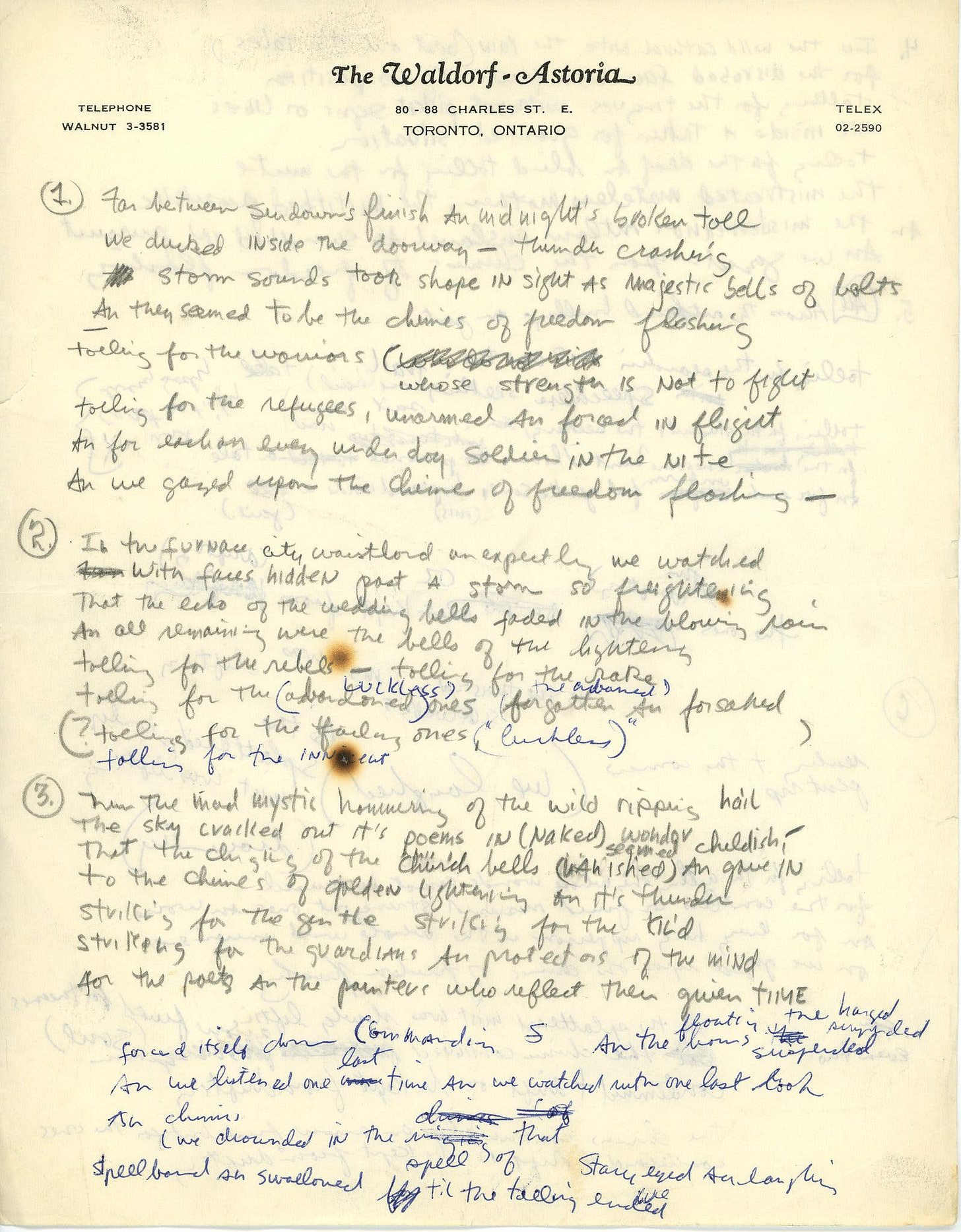
When was he there?
Another easy one to pin down, and the earliest lyric draft we’ve got. He stayed at the Waldorf-Astoria while in Toronto in early 1964 to film his performance on the CBC show Quest.
Hotel history:
Who knew there was more than one Waldorf-Astoria? The uber-famous one is, of course, in New York. Atlas Obscura christened it “New York’s Most Glamorous Hotel.” They used to hold the annual Rock and Roll Hall of Fame induction ceremonies there, including the year Dylan got in. He jammed with Billy Joel, Bruce Springsteen, Neil Young, several Beatles, and many more stars on “Like a Rolling Stone,” “Watchtower,” and a whole bunch of old-time-rock-and-roll covers.
This Waldorf-Astoria, though, was in Toronto. A real estate blog tracing the building’s history notes that the only remaining evidence of this hotel’s existence is, in fact, this very set of lyrics on this very set of stationery. Must not have been a hotel for very long. Bob Dylan writing “Chimes of Freedom” there is apparently the only notable thing about it.
I did find a few additional mentions of the hotel in Toronto newspapers from the '60s, and they all seem to concern crimes taking place there. One pair pulled silk stockings over their heads and tried to rob the place, but ran away when the clerk said no. One woman hired a hitman to murder her lover’s wife over drinks at the bar. And a bunch of restaurant diners took the opportunity of a hotel fire to skip out on their bill:
Must have been a lot of diners to pull a $2,000 bill when lunch only cost seventy-five cents.
Alternate lyrics:
95% of the lyrics are how they’d appear on the album. I found only four lines that were fairly different:
storm sounds took shape in sight as majestic bells of bolts [verse 1]
with faces hidden past a storm so frightening [verse 2]
That the clinging of the church bells vanished and gave in [verse 3]
for the poets and the painters who reflect their quiet time [verse 3]
Stationery review:
Unassuming. Songwriters in residence there probably appreciated that the logo takes up so little writing space. Also, finally, some stationery that tells you how to contact the hotel via Telex.
That’s it for Part 1: North America! Coming up soon, Part 2: The Rest of the World. It is—fair warning—even longer, with even more song lyrics scrawled on even more hotel pads. Also, for some strange reason his handwriting seems to improve overseas, so we get a lot more complete “lost verses” than we did today.
So consider this part the appetizer. Part two is the main course.
If you don’t already, subscribe below to get it delivered straight to your inbox:


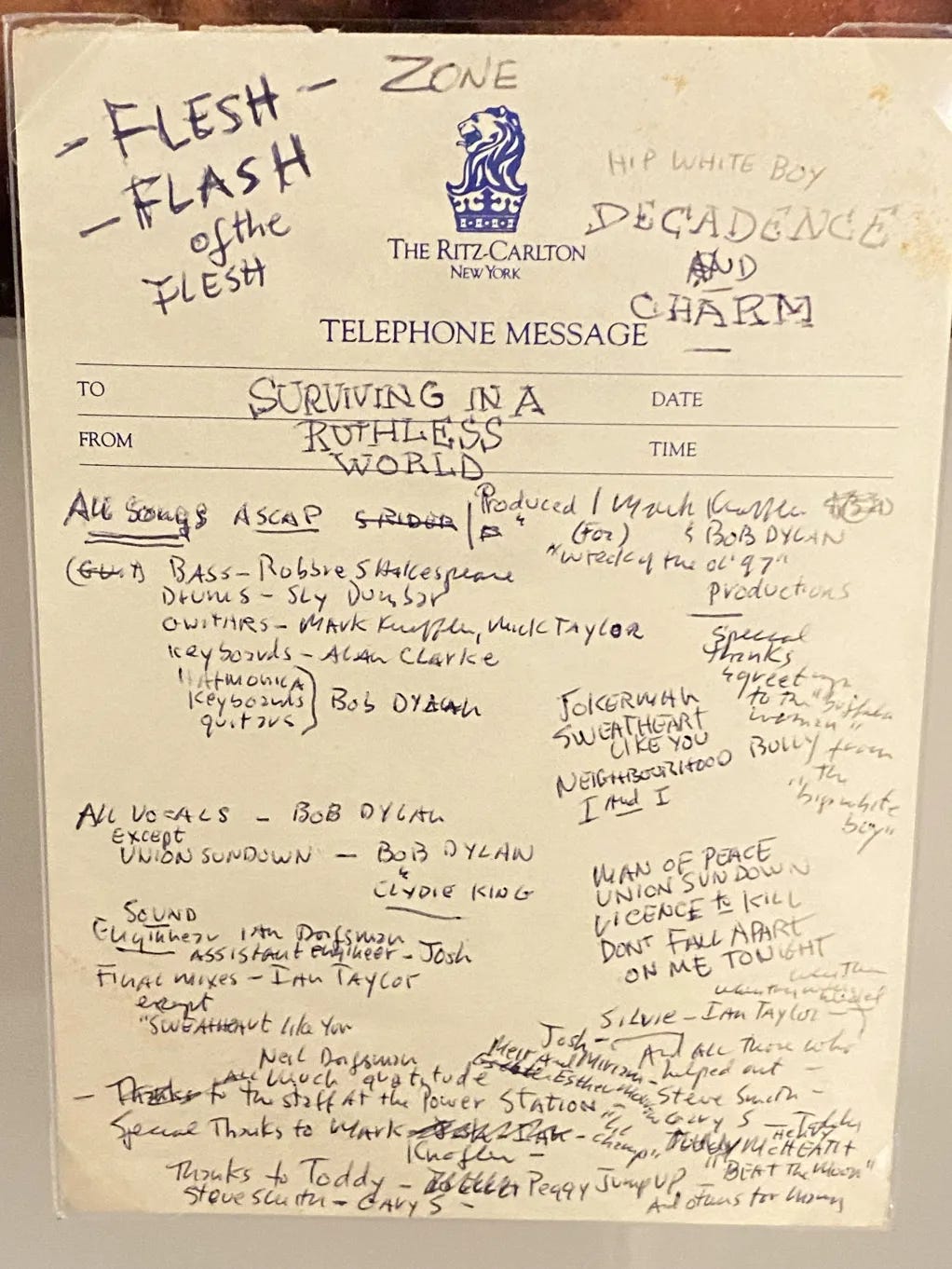
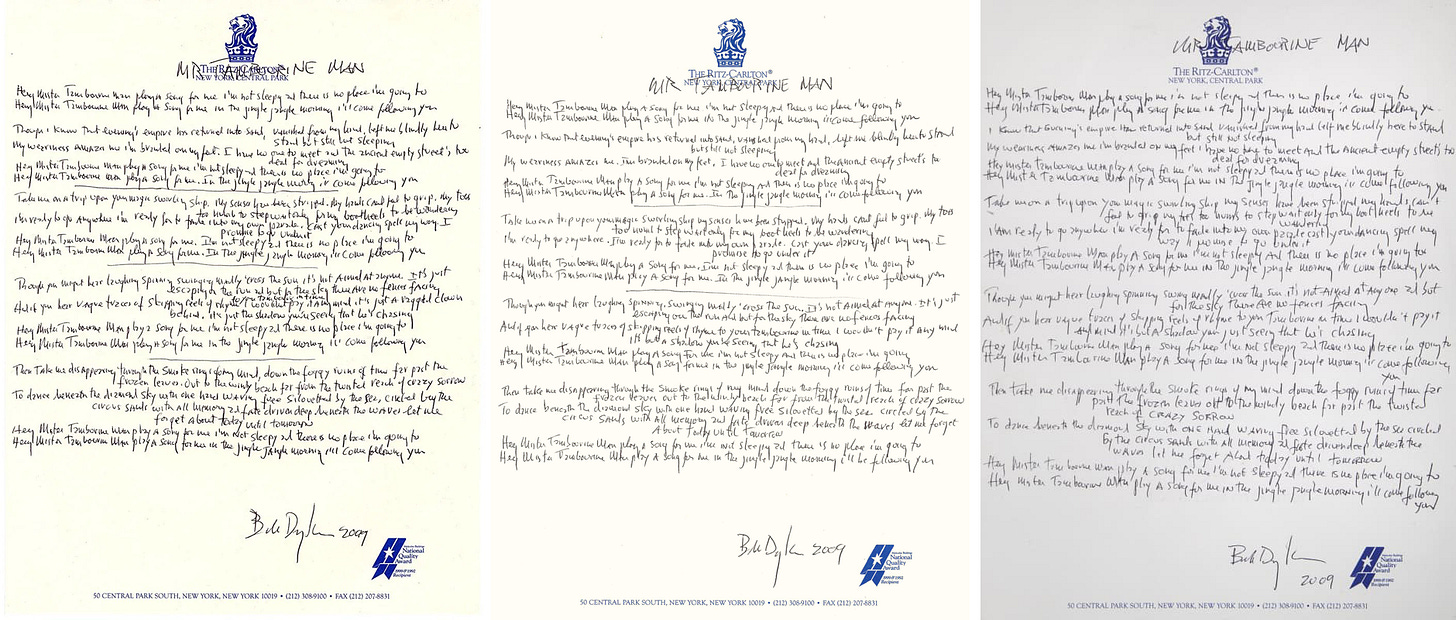




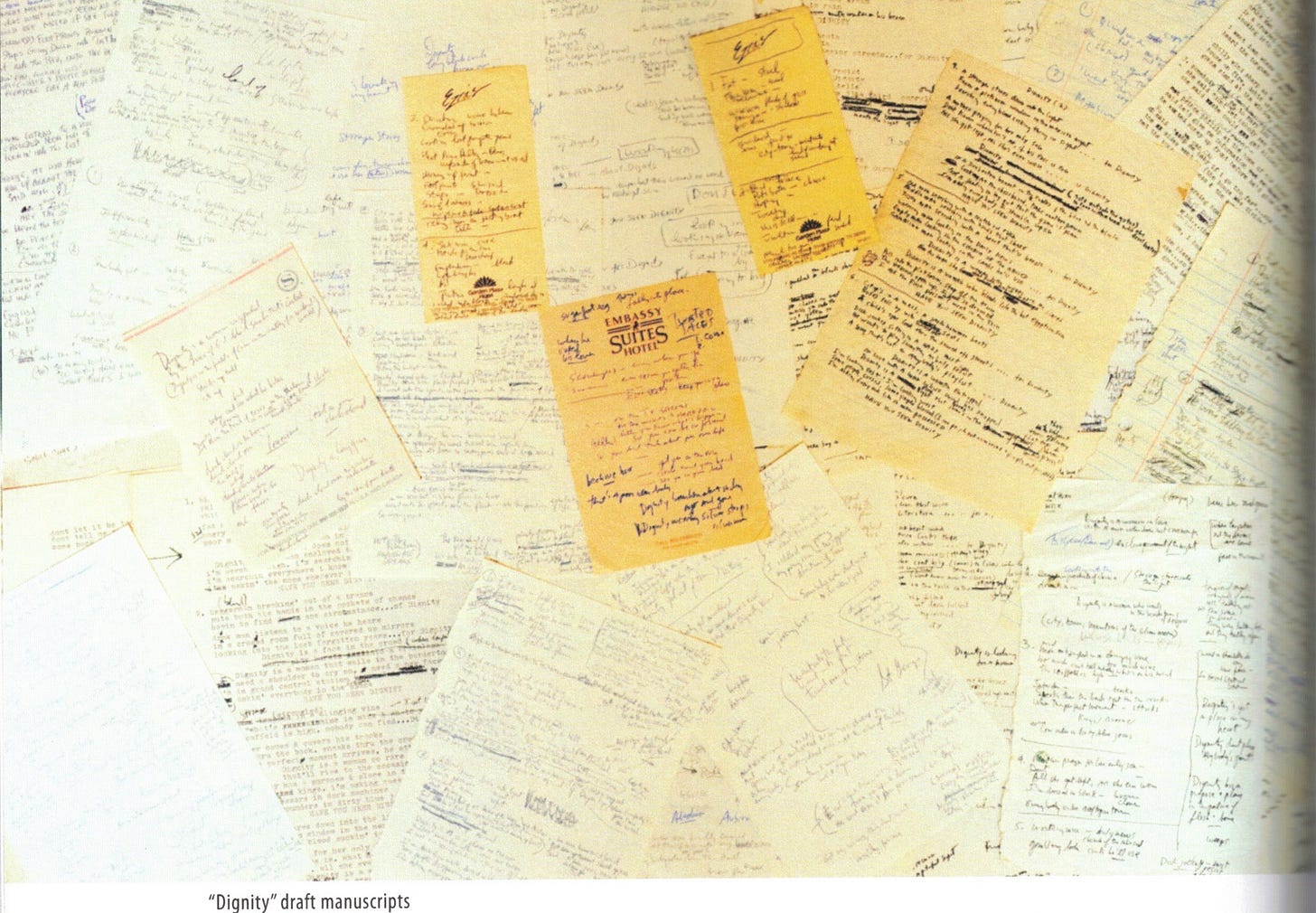



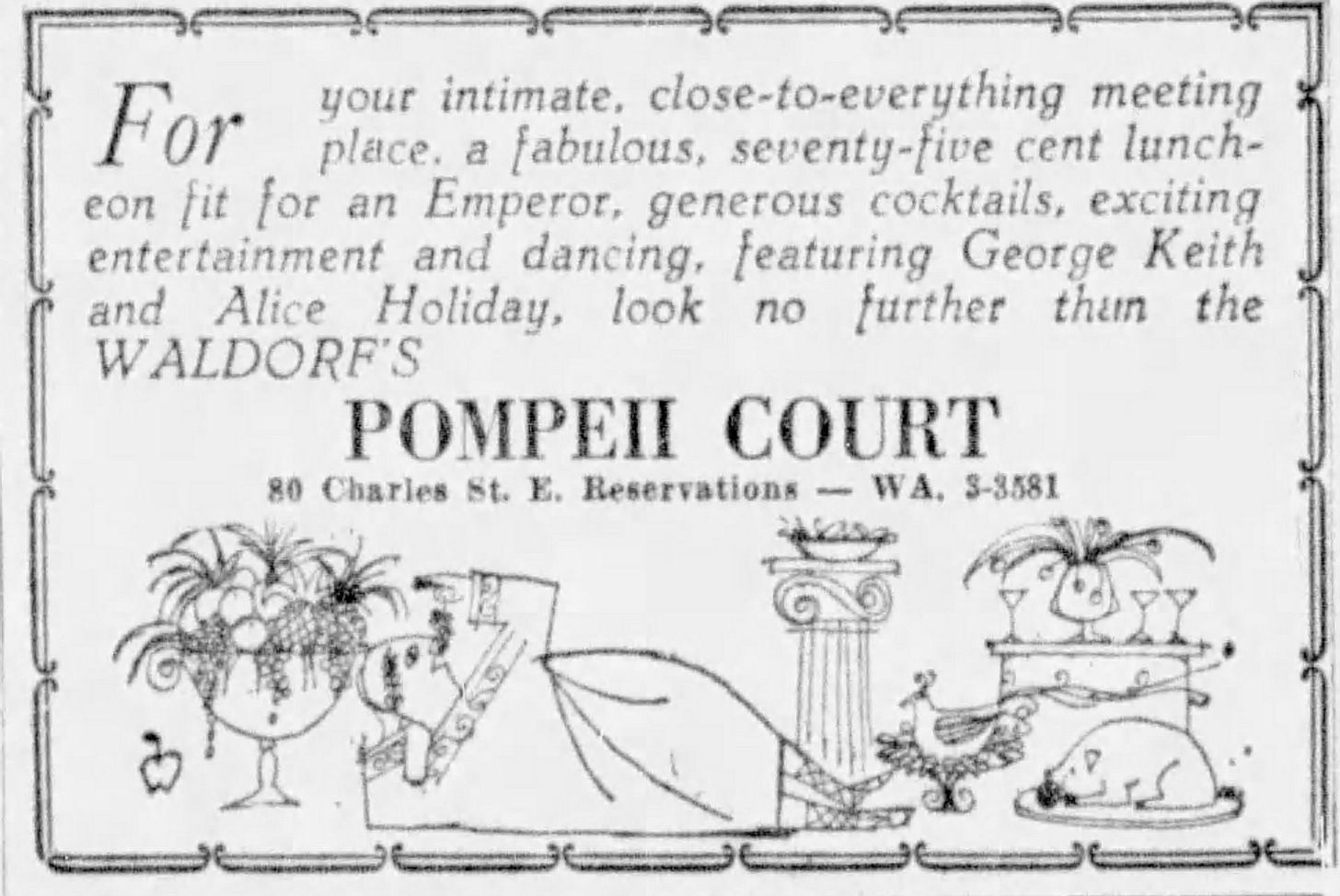
You are amazing ! This was wonderful!
love this one, Ray.